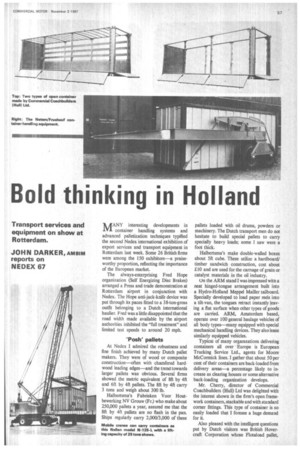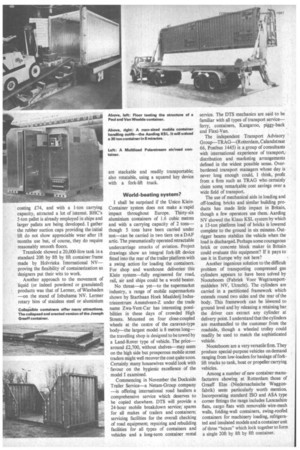Bold thinking in Holland
Page 59

Page 60

If you've noticed an error in this article please click here to report it so we can fix it.
MANY interesting developments in container handling systems and advanced palletization techniques typified the second Nedex international exhibition of export services and transport equipment in Rotterdam last week. Some 26 British firms were among the 150 exhibitors—a praiseworthy proportion, reflecting the importance of the European market.
The always-enterprising Fred Hope organization (Self Energizing Disc Brakes) arranged a Press and trade demonstration at Rotterdam airport in conjunction with Nedex. The Hope anti-jack-knife device was put through its paces fitted to a 38-ton-gross outfit belonging to a Dutch international haulier. Fred was a little disappointed that the road width made available by the airport authorities inhibited the "full treatment" and limited test speeds to around 20 mph.
'Posh' pallets
At Nedex I admired the robustness and fine finish achieved by many Dutch pallet makers. They were of wood or composite construction—often with chamfered hardwood leading edges—and the trend towards larger pallets was obvious. Several firms showed the metric equivalent of 8ft by 411 and 6ft by 411 pallets. The 8ft by 411 carry 3 tons and weigh about 300 lb.
Halbertsma's Fabrieken Voor Houtbewerking NV Grouw (Fr.) who make about 250,000 pallets a year, assured me that the 811 by 411 pallets are no flash in the pan. Ships regularly carry 2,000/3,000 of these pallets loaded with oil drums, powders or machinery. The Dutch transport men do not hesitate to build special pallets to carry specially heavy loads; some I saw were a foot thick.
Halbertsma's make double-walled boxes about 511 cube. These utilize a hardboard/ timber sandwich construction, cost about £10 and are used for the carnage of grain or catalyst materials in the oil industry.
On the ARM stand I was impressed with a neat hinged-tongue arrangement built into a Hydro-Holland Meppel Mailer tailboard. Specially developed to load paper reels into a tilt-van, the tongues retract instantly leaving a flat surface when other types of goods are carried. ARM, Amsterdam based, operate over 100 general haulage vehicles of all body types—many equipped with special mechanical handling devices. They also lease similarly equipped vehicles.
Typical of many organizations delivering containers all over Europe is European Trucking Service Ltd., agents for Moore McCormick lines. I gather that about 50 per cent of their containers are back-loaded from delivery areas—a percentage likely to increase as clearing houses or some alternative back-loading organization develops.
Mr. Cherry, director of Commercial Coachbuilders (Hull) Ltd was delighted with the interest shown in the firm's open framework containers, stackable and with standard corner fittings. This type of container is so easily loaded that I foresee a huge demand for it.
Also pleased with the intelligent questions put by Dutch visitors was British Hovercraft Corporation whose Flotaload pallet,
casting £74, and with a 1-ton carrying capacity, attracted a lot of interest. BFIC's 5-ton pallet is already employed in ships and larger pallets are being developed. I gather the rubber suction caps providing the initial lift do not show appreciable wear after 18 months use but, of course, they do require reasonably smooth floors.
Translode showed a 20,000-litre tank in a standard 20ft by 8ft by 8ft container frame made by Holvrieka International NV— proving the flexibility of containerization as designers put their wits to work.
Another approach to the movement of liquid (or indeed powdered or granulated) products was that of Lermer, of Wiesbaden —on the stand of Inbuhama NV. Lermer rotary bins of stainless steel or aluminium are stackable and readily transportable; also rotatable, using a squared key device with a fork-lift truck.
World-beating system?
I shall be surprised if the Unico KleinContainer system does not make a rapid impact throughout Europe. Thirty-six aluminium containers of 1.6 cubic metres and with a carrying capacity of 2 tons— though 5 tons have been carried under test—can be carried in two tiers on a DAF artic. The pneumatically operated retractable undercarriage smacks of aviation. Project drawings show an integral fork-lift device fitted into the rear of the trailer platform with a swing action for loading the containers. For shop and warehouse deliveries this Klein system fully engineered for road, rail, air and ships could be a world beater.
No threat—as yet--to the supermarket industry, a range of mobile supermarkets shown by Startbaan Hoek Maalderij Industriecentrum Amstelveen-Z under the trade name Zwa-Vent-Car has interesting possibilities in these days of crowded High Streets. Mounted on four close-coupled wheels at the centre of the caravan-type body—the largest model is 8 metres long— the travelling shop is designed to be towed by a Land-Rover type of vehicle. The price— around £2,700, without shelves—may seem on the high side but prosperous mobile street traders might well recover the cost quite soon. Certainly many housewives would look with favour on the hygienic excellence of the model I examined.
Commencing in November the Dockside Trailer Service—a Netam-Group company —is offering international road hauliers a comprehensive service which deserves to be copied elsewhere. DTS will provide a 24-hour mobile breakdown service; spares for all makes of trailers and containers; servicing facilities for the overall checking of road equipment; repairing and rebuilding facilities for all types of containers and vehicles and a long-term container rental service. The DTS mechanics are said to be familiar with all types of transport service— ferry, containers, Kangaroo, piggy-back and Flexi-Van.
The independent Transport Advisory Group—TRAG—(Rotterdam, Calandstraat 66, Postbus 1445) is a group of consultants with international experience of transport, distribution and marketing arrangements defined in the widest possible sense. Overburdened transport managers whose day is never long enough could, I think, profit from a firm such as TRAG who certainly claim some remarkable cost savings over a wide field of transport.
The use of mechanical aids in loading and off-loading bricks and similar building products has made little impact in Britain, though a few operators use them, Aarding NV showed the Klaus KSL system by which a 13-ton platform load of bricks is lowered complete to the ground in six minutes. Outrigger beams stabilize the vehicle when the load is discharged. Perhaps some courageous brick or concrete block maker in Britain could evaluate this equipment? If it pays to use it in Europe why not here?
Another ingenious solution to the difficult problem of transporting compressed gas cylinders appears to have been solved by Nooteboom (Fabriek Voor Wegtransportmiddelen NV, Utrecht). The cylinders are carried in a partitioned framework which extends round two sides and the rear of the body. This framework can be lowered to ground level and by releasing a retaining bar the driver can extract any cylinder at delivery point. I understand that the cylinders are manhandled to the customer from the roadside, though a wheeled trolley could readily be used to match the sophisticated vehicle.
Nooteboom are a very versatile firm. They produce special-purpose vehicles on demand ranging from low-loaders for haulage of forklift trucks to tank, boat or propeller carrying vehicles.
Among a number of new container manufacturers showing at Rotterdam those of Graaff Elze (Niedersachsische Waggonfabrik) seem particularly worth mention. Incorporating standard ISO and ASA type corner fittings the range includes Lancashire flats, cargo flats with removable wire-mesh walls, folding-wall containers, swing-roofed containers for machinery loading, refrigerated and insulated models and a container unit of three "boxes" which lock together to form a single 20ft by 8ft by 8ft container.








































































































































